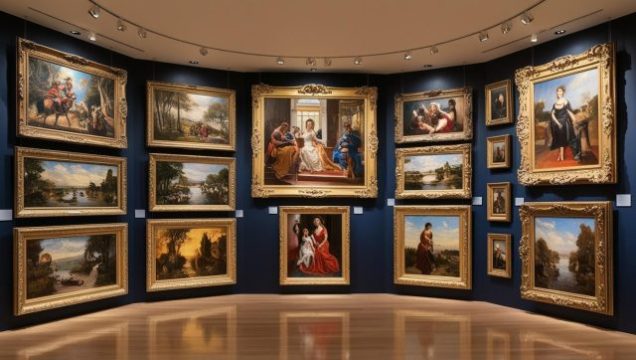Art has always been more than just something we see—it’s a reflection of the human spirit, a way to capture fleeting moments of beauty, emotion, and history. The 10 most expensive paintings in the world are prime examples of this, having transcended their medium to become iconic symbols of cultural and artistic excellence. These masterpieces have mesmerized collectors, museums, and art lovers alike, sparking fierce bidding wars and commanding staggering prices to own a piece of history.
The world’s most expensive paintings are far from ordinary creations—they represent the height of artistic brilliance, infused with stories of passion, mystery, and legacy. From Jackson Pollock’s dynamic abstracts to Leonardo da Vinci’s serene masterpieces, these works chart the evolution of art itself. In this journey, we’ll explore the highest valuable and revered masterpieces ever sold, each one serving as a powerful testament to art’s ability to move, inspire, and endure.
10. Masterpiece (US$165 million)
By Roy Lichtenstein
The 1962 painting Masterpiece is a landmark work in pop art. It blends comic book aesthetics with fine art, using bold outlines, Ben-Day dots, and a vivid color palette to both celebrate and satirize popular culture.
The painting shows a blonde woman speaking to a dark-haired man, with her speech bubble saying, “Why, Brad darling, this painting is a masterpiece! My, soon you’ll have all of New York clamoring for your work!” This narrative reflects Lichtenstein’s fascination with the connection between words and images, while also satirizing the art world’s obsession with fame.
In January 2017, Masterpiece sold for US$165 million / €156.8 million, making it one of the most expensive paintings in the world. The proceeds went to the Art for Justice Fund, supporting criminal justice reform. This sale highlights the painting’s immense value and its contribution to social change.
Masterpiece has appeared in major exhibitions, including Lichtenstein’s largest retrospective, which toured The Art Institute of Chicago, the National Gallery of Art, the Tate Modern, and the Centre Pompidou between 2012 and 2013. These exhibitions cemented its importance in both pop art and Lichtenstein’s legacy.
Through Masterpiece, Lichtenstein challenges the boundaries between high art and popular culture, inviting viewers to rethink traditional artistic hierarchies. As one of the most expensive paintings ever sold, it remains a symbol of his lasting influence on contemporary art.
9. Nu couché (US$170.4 million)
By Amedeo Modigliani
Painted in 1917 by Amedeo Modigliani, “Nu couché” showcases his innovative approach to the traditional nude. Commissioned by his dealer and friend, Léopold Zborowski, this oil on canvas features a reclining female nude. Modigliani’s signature elongated form and graceful curves convey sensuality and confidence, challenging traditional depictions of the nude.
When Nu couché debuted in December 1917 at Modigliani’s first solo exhibition, it sparked public outrage. The police intervened, demanding the removal of his nude works from the gallery’s window. This incident highlighted the provocative nature of Modigliani’s art, marking his break from traditional norms.
In the art market, “Nu couché” made history. In November 2015, it sold for US$170.4 million / €162.8 million at Christie’s in New York, setting a record for the artist. Chinese businessman Liu Yiqian bought the painting, paying with his American Express card. This sale reflects the global admiration for Modigliani’s work and its lasting value.
Today, “Nu couché” resides in the Long Museum in Shanghai, where it captivates with its bold composition and fascinating backstory. The painting blends classical influences with modernist sensibilities, making it both timeless and avant-garde.
8. Les Femmes d’Alger “Version O” (US$179.4 million)
By Pablo Picasso
Completed in 1955, Les Femmes d’Alger “Version O” ranks among the 20th century’s utmost celebrated works. Part of a 15-piece series inspired by Eugène Delacroix’s 1834 painting, this version stands out as the most dynamic and complex. With fragmented forms, bold colors, and an energetic composition, it showcases Picasso’s mastery of Cubism and his ability to reinvent historical themes through a modern lens.
Picasso created the series as a tribute to Delacroix and a reflection on his admiration for Henri Matisse, who passed away in 1954. He used it to engage with Orientalist traditions while pushing abstraction’s boundaries. The contorted, overlapping figures maintain a sense of sensuality and intimacy. His signature deconstruction of form allows multiple perspectives to coexist, making the painting feel alive with movement.
This masterpiece made headlines when it sold at Christie’s in May 2015 for US$179.4 million / €171.4 million, becoming one of the most expensive paintings in the world that was auctioned. Former Qatari Prime Minister Hamad Bin Jassim Bin Jaber Al Thani acquired it, adding to his prestigious modern art collection. The record-breaking sale reinforced Picasso’s lasting impact and the high demand for his revolutionary work.
Today, Les Femmes d’Alger “Version O” remains a defining example of Picasso’s genius. It merges past and present, tradition and innovation, and order and chaos on a single canvas. Its vibrant energy and radical composition continue to inspire, proving Picasso’s influence is as strong as ever.
7. Wasserschlangen II (US$183.8 million)
By Gustav Klimt
Mesmerizing with its beauty, femininity, and sensuality, Wasserschlangen II (Water Serpents II) showcases Klimt’s mastery of symbolism and ornamentation. Painted between 1904 and 1907, it belongs to his “Golden Period,” when he infused his work with gold leaf, intricate patterns, and dreamlike sensuality. Blending reality with fantasy, the piece reflects his deep fascination with the female form.
Unlike The Kiss, which depicts romantic love, Wasserschlangen II explores secret feminine connections and desire. Elongated female figures intertwine in a golden, watery realm, their bodies curving like serpents. Their languid expressions create a hypnotic effect, while delicate pastel tones and Klimt’s signature gold accents enhance the dreamlike atmosphere.
The painting’s history adds to its intrigue. Nazis stole it from a Jewish collector during World War II, and it later resurfaced in private collections. In 2013, Russian billionaire Dmitry Rybolovlev bought it for US$183.8 million / €175.6 million, making it one of the most expensive paintings in world history. This staggering price reflects both its artistic brilliance and turbulent past.
Even today, Wasserschlangen II remains one of Klimt’s utmost seductive and enigmatic works. It transforms sensuality into art, drawing viewers into a secret universe of passion and beauty. Whether admired for its aesthetics or history, this masterpiece proves Klimt’s vision of feminine beauty is truly timeless.
6. No. 6 “Violet, Green and Red” (US$186 million)
By Mark Rothko
This is more than a painting—it’s an experience. Created in 1951, Mark Rothko’s No. 6 “Violet, Green, and Red” exemplifies his Color Field style, where layered expanses of color evoke deep, almost spiritual emotions. Unlike traditional artworks, it has no subject, instead using color as a language of the soul.
At first sight the painting seems simple—blocks of violet, green, and red with soft edges. But the colors pulse and interact, creating a meditative effect. The moody violet dominates, while the deep green and fiery red hover and dissolve, pulling the eye in and out of focus. This interplay creates a sense of depth, as if drawing the viewer into infinite contemplation.
Rothko explored human existence—tragedy, ecstasy, and the unknown. He rejected decorative art, seeking instead to express raw emotion. He famously stated, “I’m interested only in expressing basic human emotions.” No. 6 embodies this philosophy, creating a silent yet powerful dialogue between artist and viewer.
In 2014, Russian billionaire Dmitry Rybolovlev bought No. 6 for US$186 million / €177.7 million, making it one of the most expensive paintings in the world ever sold. This record-breaking sale cemented Rothko’s status as a sought-after artist.
Yet, No. 6 is more than its price—it proves the power of abstraction. It rejects the idea that a painting must represent something specific. Instead, it invites viewers to project their emotions, making each experience unique. In a world obsessed with details, Rothko reminds us that profound truths can exist in the simplest forms.
5. Number 17A (US$200 million)
By Jackson Pollock
A whirlwind of color and motion, Number 17A (1948) by Jackson Pollock showcases abstract expressionism at its most powerful. Pollock revolutionized painting by abandoning traditional brushwork, splattering and pouring paint to create a dynamic web of interwoven colors.
At first, the composition seems chaotic, but every drip and swirl follows a controlled rhythm. Pollock painted with the canvas on the ground, moving around it like a performer and letting gravity and motion shape the paint’s flow. His work rejects clear subjects and structured compositions, focusing instead on raw emotion and movement.
In 2016, billionaire Kenneth C. Griffin bought Number 17A for US$200 million / €191 million, reinforcing Pollock’s influence and the impact of abstract expressionism. The painting continues to challenge and inspire, urging viewers to embrace unpredictability and experience art as pure, unfiltered expression.
4. Nafea Faa Ipoipo? “When Will You Marry?” (US$210 million)
By Paul Gauguin
Painted in 1892, Nafea Faa Ipoipo? (When Will You Marry?) is a vibrant masterpiece by Paul Gauguin, capturing love, longing, and the mystique of the South Pacific. With lush colors and emotional depth, it reflects his deep connection to Tahiti, a land that captivated him like no other.
At its center, two Tahitian women sit in a dreamlike landscape. One, adorned with flowers and dressed in bright colors, contrasts with the partially nude figure beside her. Their serene yet wistful gazes echo the question in the title—a quiet yearning for love and connection. The contrast between vivid colors and tender subject matter adds emotional depth, drawing viewers into the scene.
Gauguin’s rich palette enhances the painting’s romanticism. Warm golden skin tones, deep greens of the foliage, and cool blues of the distant ocean create harmony, making the land feel alive. His use of color not only highlights Tahiti’s beauty but also reflects his passion for its people and culture.
This work is an intimate glimpse into a paradise where love and nature intertwine, frozen in time through Gauguin’s lens. In 2015, it sold for a record USS$210 million / €199.6 million, acquired by Qatari royal Hamad Bin Jassim. Its immense value speaks to both Gauguin’s genius and the enduring allure of his romantic vision.
More than a question, When Will You Marry? is a timeless expression of love and longing, where emotion is conveyed not in words, but in color.
3. The Card Players (US$250 million)
By Paul Cézanne
More than just a painting, one of the most expensive paintings in the world “The Card Players” is a study of focus, time, and narrative. Completed in the early 1890s, it is one of five versions exploring the simple yet profound act of card playing. Cézanne transforms this everyday scene into something almost ceremonial, layering psychological and formal tension to create a visual experience that goes beyond its subject..
The painting shows two men seated at a table, deeply absorbed in their game. Their still, sculptural forms exude concentration, their faces marked by a haunting detachment. Cézanne’s thick brushstrokes and muted earthy tones give the figures weight, emphasizing their quiet intensity. The contrast between their solid presence and the delicate fragility of the cards hints at themes of chance and fate.
An eerie stillness fills the space between them, heightening the psychological depth. They seem locked in their own world, entirely consumed by the moment. Cézanne’s structured background, with its geometric forms and rich textures, adds to the painting’s material presence. Even a simple table becomes a meditation on form, structure, and human nature.
Beyond realism, “The Card Players” embodies Cézanne’s search for a deeper truth—one that blends the physical, psychological, and emotional. In 2011, it was sold for US$250 million / €237.6 million to Qatar’s royal family, one of the highest prices in history. Yet, its real value lies in its quiet complexity, urging viewers to see beyond the surface into the depths of human experience. Through this deceptively simple scene, Cézanne captures the delicate balance of stillness and movement, order and chaos—echoing the human condition itself.
2. Interchange (US$300 million)
By Willem de Kooning
An electrifying explosion of color, texture, and movement—an embodiment of Abstract Expressionism’s raw emotional power. The canvas pulses with vibrant reds, oranges, yellows, and blues, where aggressive, sweeping strokes and chaotic swirls intertwine in a dramatic dance. Figures emerge, distorted yet human, embodying both energy and alienation. Painted in 1955 by Willem de Kooning “Interchange” the painting doesn’t offer quiet reflection; it demands visceral engagement, pulling the viewer into a world where the boundaries between chaos and control blur.
De Kooning’s mastery lies in his ability to balance the violent, dynamic energy of his brushstrokes with moments of structure, creating an unsettling yet harmonious whole. The forms, seemingly in constant motion, create a sense of tension—figures appear to both emerge and disintegrate as the paint takes on a life of its own. There’s a psychological depth in the work, drawing out feelings of both isolation and connection.
When Interchange was sold for US$300 million / €286.6 million in 2016, it became one of the most expensive paintings in the world ever sold, reinforcing de Kooning’s legacy as a leading force in modern art. But the true value of the work lies in the way it compels the viewer to confront the primal emotions beneath the surface—intense, unpredictable, and deeply human. The painting, at its core, is a testament to the wild beauty of life, captured in a single moment of pure, untamed expression.
1. Salvator Mundi (US$450.3 million)
By Leonardo da Vinci
Finally in the top spot “Salvator Mundi”, created by Leonardo da Vinci around 1500, stands as one of the most enigmatic and significant works in the history of art. Depicting Christ as the “Savior of the World,” the painting showcases Leonardo’s exceptional skill in capturing the human form with unmatched precision and depth. Christ is presented with his right hand raised in blessing and his left holding a crystal orb—symbols of divinity and power—set against a dark, ethereal background that draws the viewer’s attention entirely to the figure.
What sets “Salvator Mundi” apart is Leonardo’s innovative use of light and shadow, a technique known as chiaroscuro. The play of light across Christ’s face and robes imparts a lifelike quality that transcends mere representation, giving the figure an almost divine presence. The deep gaze of Christ, piercing yet serene, suggests a powerful spirituality, evoking both the human and the celestial in a single moment.
For centuries, the painting was lost to history, with its attribution to Leonardo remaining uncertain until its rediscovery in 2005. After extensive restoration and authentication, it was confirmed as an original work by the Renaissance master. This revelation sparked a global sensation, and in 2017, “Salvator Mundi” was sold at auction for an astounding US$450.3 million / €430.2 million, setting a record as the most expensive paintings in world history ever sold. However, the “Mona Lisa” by the same artist is considered priceless and could fetch over US$1 billion if it were ever sold.
Beyond its monetary value, “Salvator Mundi” represents the enduring legacy of Leonardo da Vinci’s genius. It’s a work that has captivated generations, inspiring awe and reverence for its mastery and its deep, spiritual resonance. As the final word in the saga of the world’s greatest artworks, “Salvator Mundi” stands as a testament to the eternal nature of art and its power to transcend time, leaving us to ponder not just the masterpiece itself, but the visionary artist behind it.



